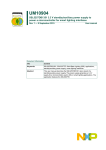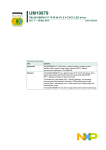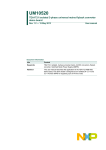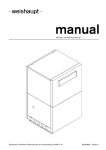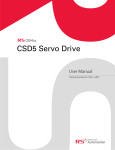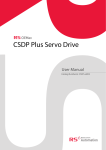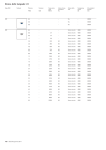Download UM10903 - NXP Semiconductors
Transcript
UM10903 SSL5261DB1350 120 V/18 W and 230 V/36 W dual-stage dimmable non-isolated LED driver board with VLC option Rev. 1 — 3 November 2015 User manual Document information Info Content Keywords SSL5261DB1350, SSL5261AT, SSL5261PT, SSL5257TE, SSL applications, dual-stage, boost PFC, buck, dimmable, non-isolated LED driver, microcontroller/auxiliary power supply, Visual Light Communication (VLC) Abstract This user manual describes the SSL5261DB1350 dual-stage dimmable non-isolated LED driver board used in Solid-State Lighting (SSL) fixture applications. The SSL5261DB1350 LED driver board includes an auxiliary supply for a microcontroller used, for instance, in smart lighting application. The SSL5261DB1350 LED driver board accommodates for Visual Light Communication (VLC) applications. It features the SSL5261AT, SSL5261PT, and SSL5257TE ICs. UM10903 NXP Semiconductors SSL5261DB1350 120 V/18 W and 230 V/36 W LED driver board Revision history Rev Date Description v.1 20151103 first issue Contact information For more information, please visit: http://www.nxp.com For sales office addresses, please send an email to: [email protected] UM10903 User manual All information provided in this document is subject to legal disclaimers. Rev. 1 — 3 November 2015 © NXP Semiconductors N.V. 2015. All rights reserved. 2 of 26 UM10903 NXP Semiconductors SSL5261DB1350 120 V/18 W and 230 V/36 W LED driver board 1. Introduction WARNING Lethal voltage and fire ignition hazard The non-insulated high voltages that are present when operating this product, constitute a risk of electric shock, personal injury, death and/or ignition of fire. This product is intended for evaluation purposes only. It shall be operated in a designated test area by personnel qualified according to local requirements and labor laws to work with non-insulated mains voltages and high-voltage circuits. This product shall never be operated unattended. The SSL5261DB1350 is a demo board featuring a dual-stage dimmable non-isolated power supply consisting of a boost PFC using the SSL5261AT, a buck controller using the SSL5261PT and a 3.3 V microcontroller/auxiliary buck power supply using the SSL5257TE. The PCB incorporates a fixture form factor with a minimum component count. Target applications are fixture, downlight, and smart lighting applications using microcontrollers having both analog and Pulse Width Modulation (PWM) dimming capabilities. Visual Light Communication (VLC) is accommodated for in the application. The single PCB dimensions are 110 mm 39 mm 24 mm. It is designed using CEM-3 or FR4 material and a copper thickness of 80 m. The board provides a simple and effective solution for dual-stage dimmable non-isolated power supplies. 1.1 Features • • • • • • • • • • UM10903 User manual PFC controller featuring the SSL5261AT Buck controller featuring the SSL5261PT 3.3 V C/auxiliary supply for usage with microcontrollers featuring the SSL5257TE Excellent line and load regulation Open-string protection Output short Protection (OSP) High power factor and low Total Harmonic Distortion (THD) High efficiency Fast start-up Single-sided PCB with dimensions of 110 mm 39 mm 24 mm All information provided in this document is subject to legal disclaimers. Rev. 1 — 3 November 2015 © NXP Semiconductors N.V. 2015. All rights reserved. 3 of 26 UM10903 NXP Semiconductors SSL5261DB1350 120 V/18 W and 230 V/36 W LED driver board 2. Safety warning The SSL5261DB1350 demo board is connected to the mains input. Avoid touching the board while it is connected to the mains voltage and when it is in operation. Isolated housing is obligatory when used in uncontrolled, non-laboratory environments. Galvanic isolation from the mains phase using a fixed or variable mains transformer is always recommended. Figure 1 shows the symbols that identify the isolated and non-isolated devices. Use a diffuser cover to avoid LED light in contact with the eyes. 019aab174 019aab173 a. Isolated Fig 1. UM10903 User manual b. Not isolated Isolation symbols All information provided in this document is subject to legal disclaimers. Rev. 1 — 3 November 2015 © NXP Semiconductors N.V. 2015. All rights reserved. 4 of 26 UM10903 NXP Semiconductors SSL5261DB1350 120 V/18 W and 230 V/36 W LED driver board 3. Specifications Table 1. SSL5261DB1350 specifications Symbol Parameter Value at Vmains = 120 V Value at Vmains = 230 V - IC used SSL5261AT SSL5261AT SSL5261PT SSL5261PT SSL5257TE SSL5257TE Vmains AC mains supply voltage 120 V (AC); 10 % 230 V (AC); 10 % Pout nominal output power 18 W 36 W VLED LED output voltage 40 V to 80 V (60 V nominal) 100 V to 125 V (120 V nominal) ILED LED output current 300 mA 300 mA ILED(ripple)[1] LED output current ripple < 5 %; 120 Hz < 5 %; 100 Hz ILED(Vmains)/ILED(nom) line regulation < 0.1 % at Vmains = ±10 % < 0.1 % at Vmains = 10 % ILED(VLED)/ILED(nom) load regulation < 1 % at VLED = 10 % < 0.5 % at VLED = 10 % efficiency > 89 % > 92 % PF power factor > 0.97 > 0.97 THD total harmonic distortion < 12 % < 12 % tstartup start-up time < 300 ms < 300 ms fsw switching frequency PFC: 45 kHz to 150 kHz; buck: 75 kHz PFC: 45 kHz to 150 kHz; buck: 110 kHz OVP overvoltage protection or open-string protection VLED > 125 V; Pin < 0.5 W VLED > 125 V; Pin < 0.6 W OSP[2] output short protection VLED = 0 V; Pin < 1.1 W VLED = 0 V; Pin < 1.1 W STBY standby function Pin < 75 mW Pin < 150 mW - board size (L W H) 110 mm 39 mm 24 mm 110 mm 39 mm 24 mm [1] I LED max – I LED min I LED ripple % = ------------------------------------------------------ 100 I LED max + I LED min [2] Open-string protection is triggered at VLED > 125 V UM10903 User manual All information provided in this document is subject to legal disclaimers. Rev. 1 — 3 November 2015 © NXP Semiconductors N.V. 2015. All rights reserved. 5 of 26 UM10903 NXP Semiconductors SSL5261DB1350 120 V/18 W and 230 V/36 W LED driver board 4. Board photographs a. Top view b. Bottom view Fig 2. UM10903 User manual SSL5261DB1350 demo board photographs All information provided in this document is subject to legal disclaimers. Rev. 1 — 3 November 2015 © NXP Semiconductors N.V. 2015. All rights reserved. 6 of 26 UM10903 NXP Semiconductors SSL5261DB1350 120 V/18 W and 230 V/36 W LED driver board 5. Board connections Fig 3. • • • • UM10903 User manual SSL5261DB1350 demo board connections STBY: 0 V to 5 V VLC: 500 Hz data stream; 300 mV peak-to-peak; 25 % modulation of ILED Analog dimming: 0 V to 0.6 V PWM dimming: 0 V to 3.3 V; 1 kHz; duty factor variable 0 % to 100 % All information provided in this document is subject to legal disclaimers. Rev. 1 — 3 November 2015 © NXP Semiconductors N.V. 2015. All rights reserved. 7 of 26 UM10903 NXP Semiconductors SSL5261DB1350 120 V/18 W and 230 V/36 W LED driver board 6. Functional description 6.1 PFC controller Figure 4 shows a simplified SSL5261AT internal block schematic, representing the control of the PFC controller. Figure 10 shows the schematic of the complete PFC application. This functional description refers to Figure 4 and Figure 10. 6: VWLPHU 66/$7 6 4 5 2&3 9 GLPFXUYH ',0 9 HQHUJL]H , ,UHI )% /2*,& &21752/ $1' 3527(&7,21 9 , GHPDJQHWL]DWLRQ 9&& YDOOH\ GHWHFWLRQ 9WRQ &203 *1',& '(0293 ,616 DDD Fig 4. Simplified internal block schematic describing the SSL5261AT control function The DIM pin is connected to VCC via pull-up resistor R107 in the application. The corresponding current from the internal V/I converter is at its maximum value Iref. The average current at the V/I converter output is regulated to Iref during toff by adapting the regulation voltage on the FB pin to 155 mV (See Ref. 1). The voltage on the COMP pin changes accordingly and determines the ton time. When Vton > VCOMP or VISNS > 0.9 V, the secondary stroke begins. When demagnetization/valley is detected at the DEMOVP pin and the energize level is reached or when the 40 s timer is completed, the primary stroke begins. The voltage across the auxiliary winding of L103 determines the voltage on the DEMOVP pin. To ensure that the PFC converter switches off during large inrush currents through capacitor C103 when mains voltage is applied to the LED driver, resistors R113//R114 are also connected to the DEMOVP pin. UM10903 User manual All information provided in this document is subject to legal disclaimers. Rev. 1 — 3 November 2015 © NXP Semiconductors N.V. 2015. All rights reserved. 8 of 26 UM10903 NXP Semiconductors SSL5261DB1350 120 V/18 W and 230 V/36 W LED driver board The current through inductor L103 during the primary stroke (i.e. during the ton period when the MOSFET is switched on) and through resistors R111//R112 determines the voltage on the ISNS pin (VISNS). The PFC converter operates in Boundary Conduction Mode (BCM) throughout the mains cycle. The switching frequency varies from 45 kHz to 150 kHz during each mains cycle. During regulation, the voltage on the FB pin is 150 mV. The result is a current 100 A flowing through resistor R120. The voltage on the DIV node is 12 V during normal operation. If this voltage becomes greater than VCC + 2 Vbe = 17 V (i.e. for an overvoltage condition on VBUS), transistor Q105 is in conduction. The COMP pin is discharged to ground via transistor Q103, the PFC converter stops switching. Diode D107 (BAS116H) ensures loop protection. If either resistor R117 or resistor R118 is open circuit, the COMP pin is discharged to ground via diode D107. The PFC converter then stops switching. To ensure minimum leakage current at the COMP pin when diode D107 is reverse biased, it is a low-leakage diode. To ensure reliable PFC start-up, the time constant R106 = 33 k/C105 = 1 F is chosen so that the VCC increases with the DIV signal (i.e. determined by VBUS via D101 path). The STBY function switches off the combined current source transistor Q101. The PFC (SSL5261AT) and the buck (SSL5261PT) converters are switched off. Low standby power is reached. During normal operation, the 100 A current flowing through resistor R120 and the voltage across the other resistors R117, R118, R119 because of this current, determine the voltage (VBUS) supplied to the buck converter. 6.2 3.3 V microcontroller/auxiliary supply For a detailed description, see the SSL5257DB1351 3.3 V standby/auxiliary power supply to power a microcontroller for smart lighting interfaces user manual (Ref. 4). UM10903 User manual All information provided in this document is subject to legal disclaimers. Rev. 1 — 3 November 2015 © NXP Semiconductors N.V. 2015. All rights reserved. 9 of 26 UM10903 NXP Semiconductors SSL5261DB1350 120 V/18 W and 230 V/36 W LED driver board 6.3 Buck controller supporting PWM and VLC Figure 5 shows a simplified SSL5261PT internal block schematic representing the control of the buck controller. Figure 12 shows the complete application schematic of the buck controller. This function description refers to Figure 5 and Figure 12. 6: VWLPHU 66/37 6 4 5 GLP FRQWURO ',0 2&3 HQHUJL]H ,UHI )% /2*,& &21752/ $1' 3527(&7,21 9 , GHPDJQHWL]DWLRQ 9&& YDOOH\ GHWHFWLRQ 9WRQ &203 *1',& '(0293 ,616 DDD Fig 5. Simplified internal block schematic describing the SSL5261PT control function The main difference with the SSL5261AT version is the connection of the DIM pin. The SSL5261PT controls the peak current. The SSL5261AT controls the average set point. In this way, the SSL5261PT version can be used for PWM dimming. In the application, the DIM pin is connected to VCC via resistor R202 and to ground via resistor R201. The voltage on the DIM pin is 0.6 V. The voltage on the DIM pin sets the internal OverCurrent Protection (OCP) voltage via the dim control curve and consequently the voltage on the ISNS pin V(ISNS). For more information about peak dimming control, see the SSL5261PT data sheet (Ref. 2). The FB pin is connected to ground, so it has no influence on the regulation. The capacitor (C201) on the COMP pin is charged to its maximum level with a current IREF. When Vton > VCOMP or VISNS > 0.9 V, the secondary stroke begins. When demagnetization/valley is detected at the DEMOVP pin and the energize level is reached or when the 40 s timer is completed, the primary stroke begins. UM10903 User manual All information provided in this document is subject to legal disclaimers. Rev. 1 — 3 November 2015 © NXP Semiconductors N.V. 2015. All rights reserved. 10 of 26 UM10903 NXP Semiconductors SSL5261DB1350 120 V/18 W and 230 V/36 W LED driver board The voltage across the auxiliary winding of inductor L103 determines the voltage on the DEMOVP pin. The voltage across the auxiliary winding, resistors R213, R214, and R206, and diodes D201 and D202 ensures valley detection, demagnetization, open-string protection of the LEDs, and short circuit protection of the driver output. The auxiliary voltage is VBUS / turns ratio during the secondary stroke, which is 40 V (VBUS = 400 V and turns ratio = 10). The current through inductor L201 during the primary stroke (i.e. during the ton period when the MOSFET is switched on) and through resistors R210//R211 determines the voltage on the ISNS pin (VISNS). The buck operates in BCM. The switching frequency is constant at 110 kHz at VLED = 120 V. With the DIM pin set to 0.6 V, a VLC data stream can be AC-coupled via capacitor C203 with maximum 25 % LED current modulation. The VLC data stream has a repetition rate of 500 Hz with an average value of zero. So, the VLC data stream does not influence the average LED current. The DIM and COMP pins also realize analog and PWM dimming. For analog dimming, the minimum dimming is 10 % of the nominal LED current. For PWM dimming, a 3.3 V/1 kHz PWM signal is supplied to the COMP pin via resistor R205 (100 k), realizing a dimming range from 0 % to 100 %. When using the VLC option, do not use analog or PWM dimming functions. Zener diodes D206 and D207 limit the voltage on the output to 125 V during an open-string condition without efficiency loss. Resistors R207 and R208 ensure that the LED voltage is equally divided across output capacitors C209 and C211. Output capacitors C209, C211, and inductor L202 filters the high-frequency switching signal. Damping resistor R217 dampens ringing of the modulated LED current where the LED current is modulated with a 500 Hz VLC data stream. UM10903 User manual All information provided in this document is subject to legal disclaimers. Rev. 1 — 3 November 2015 © NXP Semiconductors N.V. 2015. All rights reserved. 11 of 26 UM10903 NXP Semiconductors SSL5261DB1350 120 V/18 W and 230 V/36 W LED driver board 7. Performance 7.1 Start-up a. Vmains = 120 V b. Vmains = 230 V Fig 6. UM10903 User manual SSL5261DB1350 waveforms for VCC, DIV signal, and IPFC All information provided in this document is subject to legal disclaimers. Rev. 1 — 3 November 2015 © NXP Semiconductors N.V. 2015. All rights reserved. 12 of 26 UM10903 NXP Semiconductors SSL5261DB1350 120 V/18 W and 230 V/36 W LED driver board 7.2 ElectroMagnetic Interference (EMI) a. Vmains = 120 V b. Vmains = 230 V Fig 7. UM10903 User manual SSL5261DB1350 demo board: EMI performance All information provided in this document is subject to legal disclaimers. Rev. 1 — 3 November 2015 © NXP Semiconductors N.V. 2015. All rights reserved. 13 of 26 UM10903 NXP Semiconductors SSL5261DB1350 120 V/18 W and 230 V/36 W LED driver board 7.3 Dimming DDD ,/(' P$ $QDORJGLPYROWDJHRQ;FRQQHFWRU9 a. Analog DDD ,/(' P$ į3:0 b. PWM Fig 8. UM10903 User manual SSL5261DB1350: Dimming of SSL5261PT All information provided in this document is subject to legal disclaimers. Rev. 1 — 3 November 2015 © NXP Semiconductors N.V. 2015. All rights reserved. 14 of 26 UM10903 NXP Semiconductors SSL5261DB1350 120 V/18 W and 230 V/36 W LED driver board 7.4 VLC data modulation of LED current Fig 9. UM10903 User manual VLC data modulation of LED current All information provided in this document is subject to legal disclaimers. Rev. 1 — 3 November 2015 © NXP Semiconductors N.V. 2015. All rights reserved. 15 of 26 xxxxxxxxxxxxxxxxxxxxx xxxxxxxxxxxxxxxxxxxxxxxxxx xxxxxxx x x x xxxxxxxxxxxxxxxxxxxxxxxxxxxxxx xxxxxxxxxxxxxxxxxxx xx xx xxxxx xxxxxxxxxxxxxxxxxxxxxxxxxxx xxxxxxxxxxxxxxxxxxx xxxxxx xxxxxxxxxxxxxxxxxxxxxxxxxxxxxxxxxxx xxxxxxxxxxxx x x xxxxxxxxxxxxxxxxxxxxx xxxxxxxxxxxxxxxxxxxxxxxxxxxxxx xxxxx xxxxxxxxxxxxxxxxxxxxxxxxxxxxxxxxxxxxxxxxxxxxxxxxxx xxxxxxxx xxxxxxxxxxxxxxxxxxxxxxxxx xxxxxxxxxxxxxxxxxxxx xxx NXP Semiconductors UM10903 User manual 8. Schematic 8.1 PFC controller ' / P+ :% %' /0%673 Nȍ / P+ 0DLQV1 5 59 9 0DLQV/ ) &; Q) 9 & Q) 9 & Q) 9 WXUQVUDWLR & X) 9 5 9&&B%8&. Nȍ 5 Nȍ ' %=;& 5 ' 1: & ' 360$$ ; 9''9 $:* 5*1' 67%< 9/& QP ',9 5 0ȍ ' 5 Nȍ 4 %&% 5 67%< ',0 3:0 5 Nȍ '(0293 5 0ȍ *1' & 4 %& Q) 9 4 %& Nȍ ',0B%8&. & Q) 9 & Q) 9 5 Nȍ & Q) 9 ȍ 8 &203 %$6+ Q) 9 ( 5 0ȍ 4 ,365&$.0$ 9&&B3)& 5 5 0ȍ ' 1: 9$7 Nȍ (6- /DX[ P+ + 5*1' 4 %8-/5 0ȍ ; /SUL P+ ' 60/ 5 0ȍ 95(&7 ),/7(5 ' / 66/$7 ',9 & Q) 9 5 Nȍ )% ,616 9&& 6: 5 Nȍ & Q) 9 5*1' & ) 9 & Q) 9 5 ȍ 5 ȍ ' 7'=- 5 ȍ QP 5 ȍ ' 60/ 5 Nȍ 5*1' DDD UM10903 16 of 26 © NXP Semiconductors N.V. 2015. All rights reserved. Fig 10. SSL5261DB1350 demo board schematic with PFC controller part featuring SSL5261AT SSL5261DB1350 120 V/18 W and 230 V/36 W LED driver board Rev. 1 — 3 November 2015 All information provided in this document is subject to legal disclaimers. 5 9%86 UM10903 NXP Semiconductors SSL5261DB1350 120 V/18 W and 230 V/36 W LED driver board 8.2 3.3 V microcontroller/auxiliary supply 95(&7B),/7(5 5 ' Nȍ 6-/ 8 *$7( ,616 5 Nȍ & Q) 9 9&& &203 '5$,1 *1' & ) 9 66/7( '(0293 ',0 (3 5 Nȍ 5 ȍ & Q) 9 5 ȍ / P+ 9''9 5 Nȍ 5*1' ' (6-/ ' %=;&9 5*1' ' ) 9 5 ȍ 10 5*1' DDD Fig 11. SSL5261DB1350 demo board schematic with 3.3 V microcontroller/auxiliary part featuring SSL5257TE UM10903 User manual All information provided in this document is subject to legal disclaimers. Rev. 1 — 3 November 2015 © NXP Semiconductors N.V. 2015. All rights reserved. 17 of 26 xxxxxxxxxxxxxxxxxxxxx xxxxxxxxxxxxxxxxxxxxxxxxxx xxxxxxx x x x xxxxxxxxxxxxxxxxxxxxxxxxxxxxxx xxxxxxxxxxxxxxxxxxx xx xx xxxxx xxxxxxxxxxxxxxxxxxxxxxxxxxx xxxxxxxxxxxxxxxxxxx xxxxxx xxxxxxxxxxxxxxxxxxxxxxxxxxxxxxxxxxx xxxxxxxxxxxx x x xxxxxxxxxxxxxxxxxxxxx xxxxxxxxxxxxxxxxxxxxxxxxxxxxxx xxxxx xxxxxxxxxxxxxxxxxxxxxxxxxxxxxxxxxxxxxxxxxxxxxxxxxx xxxxxxxx xxxxxxxxxxxxxxxxxxxxxxxxx xxxxxxxxxxxxxxxxxxxx xxx 9%86 /('3 ' %=;& 5 0ȍ & ) 9 ; ' 0856 ' %=;& ' 5 ) 9 5 Nȍ & ) 9 '(0293 ',0 &203 ȍ ȍ /('0 / & Q) 9 /SUL P+ /DX[ /SUL + WXUQVUDWLR 5 ȍ 66/37 6: 9&& & Q) 9 ,616 )% 5 Nȍ 5 5 Nȍ Nȍ 5 Nȍ 5*1' Q) 9 8 *1' ',0B%8&. 5 3:0 5 & ) 9 / + 4 67'1.= 1: & 5 0ȍ & S) 9 & S) 9 5 Nȍ ' 1: ' 1: 5 5 ȍ ȍ ' 7'=- 5*1' UM10903 18 of 26 © NXP Semiconductors N.V. 2015. All rights reserved. Fig 12. SSL5261DB1350 demo board schematic with buck controller part featuring SSL5261PT DDD SSL5261DB1350 120 V/18 W and 230 V/36 W LED driver board Rev. 1 — 3 November 2015 All information provided in this document is subject to legal disclaimers. 9&&B%8&. 9/& NXP Semiconductors UM10903 User manual 8.3 Buck controller UM10903 NXP Semiconductors SSL5261DB1350 120 V/18 W and 230 V/36 W LED driver board 9. Bill Of Materials (BOM) Table 2. SSL5261DB1350 demo board BOM Reference Description and values Part number Manufacturer BD101 diode; bridge; 1 kV; 1 A LMB10S-TP MCC C210 capacitor; 4.7 nF; 10 %; 50 V; X7R; 0603 - - C211 capacitor; 1 F; 10 %; 63 V; PET; THT B32529C105K189 EPCOS C301 capacitor; 2.2 F; 20 %; 400 V; ALU; THT ECA2GHG2R2 Panasonic C302 capacitor; 330 F; 20 %; 6.3 V; ALU; THT MCUMR6V3337M8X5 Multicomp C303 capacitor; 2.7 nF; 10 %; 50 V; X7R; 0603 - - C304 capacitor; 100 nF; 10 %; 50 V; X7R; 0603 - - C305; C306 capacitor; 1 nF; 10 %; 50 V; X7R; 0603 - - CX101 capacitor; 100 nF; 20 %; 630 V; PET; THT BFC233820104 Vishay D101; D103; D108 diode; 1 kV; 1 A S1ML Taiwan Semiconductor D102 diode; 600 V; 1 A ES1J Fairchild D104 diode; Zener; 12 V; 250 mA BZX384-C12 NXP Semiconductors D105; D201; D202; diode; 100 V; 300 mA D203 1N4148W-7-F Diode Inc D109 diode; TVS; 400 V; 800 mA P4SMA400A Littelfuse D205 diode; 600 V; 1 A MURS160-E3-52T Vishay D206; D207 diode; Zener; 62 V; 300 mA BZX384-C62 NXP Semiconductors D301 diode; 420 V; 1 A S1JL Taiwan Semiconductor D302 diode; Zener; 3.6 V; 250 mA BZX384-C3V6 NXP Semiconductors D303 diode; 420 V; 1 A ES1JL Taiwan Semiconductor D304; D305 diode; Zener; 18 V; 250 mA TDZ18J NXP Semiconductors F101 fuse; slow blow; 300 V; 2.5 A 38312500000 Littelfuse L101 inductor; common-mode; 10 mH; 700 mA 744821110 Würth Elektronik L102 inductor; 1.5 mH; 10 %; 700 mA RFC1010B-155KE Coilcraft L103 inductor; 2.3 mH 750315571 Würth Elektronik L201 inductor; 1 mH 750315572 Würth Elektronik L202 inductor; 220 F; 20 %; 1.3 A; THT 7447471221 Würth Elektronik L301 inductor; 1 mH; 170 mA 22R105C Murata Q101 transistor; NPN; 400 V; 1 A BUJ100LR NXP Semiconductors Q102 MOSFET-N; 650 V; 4.5 A IPS65R950C6AKMA1 Infineon Q103; Q104 transistor; NPN; 45 V; 100 mA BC847 NXP Semiconductors Q105 transistor; PNP; 400 V; 300 mA BC857B,215 NXP Semiconductors Q201 MOSFET-N; 600 V; 2.4 A STD3NK60Z-1 STMicroelectronics R101; R102 resistor; 4.7 k; 1 %; 100 mW; 0805 - - R103; R104 resistor; 1.2 M; 1 %; 250 mW; 1206 - - R105; R106 resistor; 33 k; 1 %; 100 mW; 0603 - - R107; R115 resistor; 1 M; 1 %; 63 mW; 0603 - - R108; R122 resistor; 68 k; 1 %; 63 mW; 0603 - - R109 resistor; 5.6 k; 1 %; 250 mW; 1206 - - UM10903 User manual All information provided in this document is subject to legal disclaimers. Rev. 1 — 3 November 2015 © NXP Semiconductors N.V. 2015. All rights reserved. 19 of 26 UM10903 NXP Semiconductors SSL5261DB1350 120 V/18 W and 230 V/36 W LED driver board Table 2. SSL5261DB1350 demo board BOM …continued Reference Description and values Part number Manufacturer R110; R212 resistor; 470 ; 1 %; 100 mW; 0603 - - R111; R112 resistor; 1.8 ; 1 %; 1 W; 2512 ERJ1TRQF1R8U Panasonic R113 resistor; 0.1 ; 1 %; 1 W; 2512 RL2512FK-070R1L Yageo R114 resistor; 0.1 ; 5 %; 1 W; RSMF; THT RSMF1JTR100 Stackpole Electronics R116 resistor; 330 k; 1 %; 63 mW; 0603 - - R117 resistor; 2 M; 1 %; 250 mW; 1206 - - R118 resistor; 1.8 M; 1 %; 250 mW; 1206 - - R119 resistor; 120 k; 1 %; 63 mW; 0603 - - R120 resistor; 1.5 k; 1 %; 100 mW; 0603 - - R121 resistor; 47 k; 1 %; 100 mW; 0603 - - R201 resistor; 33 k; 1 %; 100 mW; 0603 - - R202 resistor; 820 k; 1 %; 63 mW; 0603 - - R206 resistor; 100 k; 1 %; 63 mW; 0603 - - R207; R208 resistor; 1 M; 1 %; 250 mW; 1206 - - R210 resistor; 1.8 ; 1 %; 500 mW; 0805 - - R211 resistor; 1.6 ; 1 %; 500 mW; 0805 - - R213 resistor; 51 k; 1 %; 63 mW; 0603 - - R214 resistor; 5.6 k; 1 %; 63 mW; 0603 - - R217 resistor; 47 ; 1 %; 100 mW; 0805 - - R301 resistor; 1.2 k; 5 %; 1 W; PR01; THT PR01000101201JR500 Vishay R302 resistor; 10 ; 1 %; 100 mW; 0805 - - R303 resistor; 5.1 ; 5 %; 250 mW; 1206 - - R304 resistor; 150 ; 1 %; 100 mW; 0805 - - R305 resistor; 560 k; 5 %; 63 mW; 0603 - - R306 resistor; 120 k; 5 %; 63 mW; 0603 - - R307 resistor; 150 k; 5 %; 63 mW; 0603 - - R308 resistor; 100 ; 1 %; 63 mW; 0603 - - RV101 resistor; MOV; 275 V; 75 J V275LA20AP Littelfuse U101 LED driver; SSL5261AT SSL5261AT NXP Semiconductors U201 LED driver: SSL5261PT SSL5261PT NXP Semiconductors U301 LED driver: SSL5257TE SSL5257TE NXP Semiconductors WB101 wire bridge; 0.8 mm; pitch = 10.16 mm 923345-04 3M X101 terminal block; 2-way; pitch = 10.16 mm OSTTC023162 On-Shore Tech. Inc. X201 terminal block; 3-way; pitch = 5.08 mm PM5.08/3/90 BLK Weidmüller X301 header; straight; 1 row 6-pin; pitch = 2.54 mm 22-28-4060 Molex UM10903 User manual All information provided in this document is subject to legal disclaimers. Rev. 1 — 3 November 2015 © NXP Semiconductors N.V. 2015. All rights reserved. 20 of 26 UM10903 NXP Semiconductors SSL5261DB1350 120 V/18 W and 230 V/36 W LED driver board / 10. PCB assembly and layout SSL5261DB1350 / ; & & ; / 4 4 ; 4 / & &; & & & & :% / / ) 59 5 ( & 5 DDD ' ' & & 8 ' 5 5 ' 5 5 ' 5 & & & & 5 5 5 & 5 5 & 8 4 5 & 5 ' ' ' 5 ' ' 5 8 & 5 ' 5 4 5 5 ' 5 & 5 ' ' & 5 & 5 ' 4 ' & 5 5 ' 5 5 5 5 5 5 & 5 5 5 5 & a. Top & ' 5 %' ' 5 5 5 5 5 ' DDD b. Bottom Fig 13. SSL5261DB1350 demo board PCB assembly Fig 14. SSL5261DB1350 demo board layout UM10903 User manual All information provided in this document is subject to legal disclaimers. Rev. 1 — 3 November 2015 © NXP Semiconductors N.V. 2015. All rights reserved. 21 of 26 UM10903 NXP Semiconductors SSL5261DB1350 120 V/18 W and 230 V/36 W LED driver board 11. PFC and buck inductor specifications 11.1 PFC inductor The PFC transformer is EE20/10/6, 10 pins, THT, horizontal (EF20). $ GRWORFDWHVWHUP PD[ PD[ PD[ ORWFRGHDQGGDWHFRGH WHUPQXPEHUVIRU UHIHUHQFHRQO\ 64[ SDUWPXVWLQVHUWIXOO\WR VXUIDFH$LQUHFRPPHQGHGJULG [ 35, $8; [ 'LPHQVLRQVLQPP UHFRPPHQGHG SFSDWWHUQFRPSRQHQWVLGH DDD Fig 15. PFC inductor schematic Table 3. Electrical specifications PFC inductor All values are specified at 25 C unless otherwise specified. Parameter Value Conditions DC resistance (1-5) 3.9 ; 10 % 20 C DC resistance (7-9) 0.233 ; 10 % 20 C primary inductance (1-5) 2.2 mH; 10 % 100 mV; 10 kHz leakage inductance (1-5) 150 H nominal; 250 H maximum short (7-9); 100 mV; 10 kHz saturation current (1-5) 1A turns ratio 20:1; 1 % tolerance Table 4. UM10903 User manual (1-5):(7-9) PFC inductor construction Wire Description primary wire 10-strand 0.07 mm litz wire primary number of turns 205 turns wound uniformly in 12 layers auxiliary wire 10-strand 0.07 mm litz wire auxiliary number of turns 10 turns wound uniformly in 1 layer All information provided in this document is subject to legal disclaimers. Rev. 1 — 3 November 2015 © NXP Semiconductors N.V. 2015. All rights reserved. 22 of 26 UM10903 NXP Semiconductors SSL5261DB1350 120 V/18 W and 230 V/36 W LED driver board 11.2 Buck inductor The buck inductor is EE16/8/5, 8 pins, THT, horizontal (EF16). $ FKDPIHUORFDWHVWHUP PD[ PD[ PD[ WHUPQXPEHUVIRU UHIHUHQFHRQO\ 64[ SDUWPXVWLQVHUWIXOO\WR VXUIDFH$LQUHFRPPHQGHGJULG ORWFRGHDQGGDWHFRGH [ 35, $8; [ 'LPHQVLRQVLQPP UHFRPPHQGHG SFSDWWHUQFRPSRQHQWVLGH DDD Fig 16. Buck inductor schematic Table 5. Electrical specifications buck inductor All values are specified at 25 C unless otherwise specified. Parameter Value Conditions DC resistance (1-4) 1.85 ; 10 % 20 C DC resistance (8-5) 0.22 ; 10 % 20 C primary inductance (1-4) 1 mH; 10 % 100 mV; 10 kHz leakage inductance (1-4) 28 H nominal; 40 H maximum short (8-5); 100 mV; 10 kHz saturation current (1-5) 750 mA turns ratio 10:1; 1 % tolerance Table 6. Buck inductor construction Wire UM10903 User manual (1-4):(8-5) Description primary wire 8-strand AWG41 litz wire primary number of turns 125 turns wound uniformly in 6 layers auxiliary wire 8-strand AWG41 litz wire auxiliary number of turns 13 turns wound uniformly in 1 layer All information provided in this document is subject to legal disclaimers. Rev. 1 — 3 November 2015 © NXP Semiconductors N.V. 2015. All rights reserved. 23 of 26 UM10903 NXP Semiconductors SSL5261DB1350 120 V/18 W and 230 V/36 W LED driver board 12. Abbreviations Table 7. Abbreviations Acronym Description BCM Boundary Conduction Mode CEM-3 Composite Epoxy Material 3 EMI ElectroMagnetic Interference FR4 Flame Retardant 4 grade LED Light-Emitting Diode OSP Output Short Protection OVP OverVoltage Protection PCB Printed-Circuit Board PFC Power Factor Correction PWM Pulse-Width Modulation SSL Solid-State Lighting VLC Visual Light Communication 13. References UM10903 User manual [1] SSL5261AT data sheet — Mains dimmable LED driver IC; 2015, NXP Semiconductors [2] SSL5261PT data sheet — Mains dimmable LED driver IC; 2015, NXP Semiconductors [3] SSL5257TE data sheet — Mains dimmable buck-boost LED driver IC 10 Ohm/700 V; 2015, NXP Semiconductors [4] UM10904 user manual — SSL5257DB1351 3.3 V standby/auxiliary power supply to power a microcontroller for smart lighting interfaces; 2015, NXP Semiconductors All information provided in this document is subject to legal disclaimers. Rev. 1 — 3 November 2015 © NXP Semiconductors N.V. 2015. All rights reserved. 24 of 26 UM10903 NXP Semiconductors SSL5261DB1350 120 V/18 W and 230 V/36 W LED driver board 14. Legal information 14.1 Definitions Draft — The document is a draft version only. The content is still under internal review and subject to formal approval, which may result in modifications or additions. NXP Semiconductors does not give any representations or warranties as to the accuracy or completeness of information included herein and shall have no liability for the consequences of use of such information. NXP Semiconductors does not accept any liability related to any default, damage, costs or problem which is based on any weakness or default in the customer’s applications or products, or the application or use by customer’s third party customer(s). Customer is responsible for doing all necessary testing for the customer’s applications and products using NXP Semiconductors products in order to avoid a default of the applications and the products or of the application or use by customer’s third party customer(s). NXP does not accept any liability in this respect. Export control — This document as well as the item(s) described herein may be subject to export control regulations. Export might require a prior authorization from competent authorities. 14.2 Disclaimers Limited warranty and liability — Information in this document is believed to be accurate and reliable. However, NXP Semiconductors does not give any representations or warranties, expressed or implied, as to the accuracy or completeness of such information and shall have no liability for the consequences of use of such information. NXP Semiconductors takes no responsibility for the content in this document if provided by an information source outside of NXP Semiconductors. In no event shall NXP Semiconductors be liable for any indirect, incidental, punitive, special or consequential damages (including - without limitation - lost profits, lost savings, business interruption, costs related to the removal or replacement of any products or rework charges) whether or not such damages are based on tort (including negligence), warranty, breach of contract or any other legal theory. Notwithstanding any damages that customer might incur for any reason whatsoever, NXP Semiconductors’ aggregate and cumulative liability towards customer for the products described herein shall be limited in accordance with the Terms and conditions of commercial sale of NXP Semiconductors. Right to make changes — NXP Semiconductors reserves the right to make changes to information published in this document, including without limitation specifications and product descriptions, at any time and without notice. This document supersedes and replaces all information supplied prior to the publication hereof. Suitability for use — NXP Semiconductors products are not designed, authorized or warranted to be suitable for use in life support, life-critical or safety-critical systems or equipment, nor in applications where failure or malfunction of an NXP Semiconductors product can reasonably be expected to result in personal injury, death or severe property or environmental damage. NXP Semiconductors and its suppliers accept no liability for inclusion and/or use of NXP Semiconductors products in such equipment or applications and therefore such inclusion and/or use is at the customer’s own risk. Applications — Applications that are described herein for any of these products are for illustrative purposes only. NXP Semiconductors makes no representation or warranty that such applications will be suitable for the specified use without further testing or modification. Customers are responsible for the design and operation of their applications and products using NXP Semiconductors products, and NXP Semiconductors accepts no liability for any assistance with applications or customer product design. It is customer’s sole responsibility to determine whether the NXP Semiconductors product is suitable and fit for the customer’s applications and products planned, as well as for the planned application and use of customer’s third party customer(s). Customers should provide appropriate design and operating safeguards to minimize the risks associated with their applications and products. Evaluation products — This product is provided on an “as is” and “with all faults” basis for evaluation purposes only. NXP Semiconductors, its affiliates and their suppliers expressly disclaim all warranties, whether express, implied or statutory, including but not limited to the implied warranties of non-infringement, merchantability and fitness for a particular purpose. The entire risk as to the quality, or arising out of the use or performance, of this product remains with customer. In no event shall NXP Semiconductors, its affiliates or their suppliers be liable to customer for any special, indirect, consequential, punitive or incidental damages (including without limitation damages for loss of business, business interruption, loss of use, loss of data or information, and the like) arising out the use of or inability to use the product, whether or not based on tort (including negligence), strict liability, breach of contract, breach of warranty or any other theory, even if advised of the possibility of such damages. Notwithstanding any damages that customer might incur for any reason whatsoever (including without limitation, all damages referenced above and all direct or general damages), the entire liability of NXP Semiconductors, its affiliates and their suppliers and customer’s exclusive remedy for all of the foregoing shall be limited to actual damages incurred by customer based on reasonable reliance up to the greater of the amount actually paid by customer for the product or five dollars (US$5.00). The foregoing limitations, exclusions and disclaimers shall apply to the maximum extent permitted by applicable law, even if any remedy fails of its essential purpose. Safety of high-voltage evaluation products — The non-insulated high voltages that are present when operating this product, constitute a risk of electric shock, personal injury, death and/or ignition of fire. This product is intended for evaluation purposes only. It shall be operated in a designated test area by personnel that is qualified according to local requirements and labor laws to work with non-insulated mains voltages and high-voltage circuits. The product does not comply with IEC 60950 based national or regional safety standards. NXP Semiconductors does not accept any liability for damages incurred due to inappropriate use of this product or related to non-insulated high voltages. Any use of this product is at customer’s own risk and liability. The customer shall fully indemnify and hold harmless NXP Semiconductors from any liability, damages and claims resulting from the use of the product. Translations — A non-English (translated) version of a document is for reference only. The English version shall prevail in case of any discrepancy between the translated and English versions. 14.3 Trademarks Notice: All referenced brands, product names, service names and trademarks are the property of their respective owners. GreenChip — is a trademark of NXP Semiconductors N.V. UM10903 User manual All information provided in this document is subject to legal disclaimers. Rev. 1 — 3 November 2015 © NXP Semiconductors N.V. 2015. All rights reserved. 25 of 26 UM10903 NXP Semiconductors SSL5261DB1350 120 V/18 W and 230 V/36 W LED driver board 15. Contents 1 1.1 2 3 4 5 6 6.1 6.2 6.3 7 7.1 7.2 7.3 7.4 8 8.1 8.2 8.3 9 10 11 11.1 11.2 12 13 14 14.1 14.2 14.3 15 Introduction . . . . . . . . . . . . . . . . . . . . . . . . . . . . 3 Features . . . . . . . . . . . . . . . . . . . . . . . . . . . . . . 3 Safety warning . . . . . . . . . . . . . . . . . . . . . . . . . . 4 Specifications. . . . . . . . . . . . . . . . . . . . . . . . . . . 5 Board photographs . . . . . . . . . . . . . . . . . . . . . . 6 Board connections . . . . . . . . . . . . . . . . . . . . . . 7 Functional description . . . . . . . . . . . . . . . . . . . 8 PFC controller. . . . . . . . . . . . . . . . . . . . . . . . . . 8 3.3 V microcontroller/auxiliary supply . . . . . . . . 9 Buck controller supporting PWM and VLC . . . 10 Performance . . . . . . . . . . . . . . . . . . . . . . . . . . . 12 Start-up . . . . . . . . . . . . . . . . . . . . . . . . . . . . . . 12 ElectroMagnetic Interference (EMI) . . . . . . . . 13 Dimming . . . . . . . . . . . . . . . . . . . . . . . . . . . . . 14 VLC data modulation of LED current . . . . . . . 15 Schematic . . . . . . . . . . . . . . . . . . . . . . . . . . . . . 16 PFC controller. . . . . . . . . . . . . . . . . . . . . . . . . 16 3.3 V microcontroller/auxiliary supply . . . . . . . 17 Buck controller . . . . . . . . . . . . . . . . . . . . . . . . 18 Bill Of Materials (BOM) . . . . . . . . . . . . . . . . . . 19 PCB assembly and layout SSL5261DB1350 . 21 PFC and buck inductor specifications. . . . . . 22 PFC inductor. . . . . . . . . . . . . . . . . . . . . . . . . . 22 Buck inductor . . . . . . . . . . . . . . . . . . . . . . . . . 23 Abbreviations . . . . . . . . . . . . . . . . . . . . . . . . . . 24 References . . . . . . . . . . . . . . . . . . . . . . . . . . . . 24 Legal information. . . . . . . . . . . . . . . . . . . . . . . 25 Definitions . . . . . . . . . . . . . . . . . . . . . . . . . . . . 25 Disclaimers . . . . . . . . . . . . . . . . . . . . . . . . . . . 25 Trademarks. . . . . . . . . . . . . . . . . . . . . . . . . . . 25 Contents . . . . . . . . . . . . . . . . . . . . . . . . . . . . . . 26 Please be aware that important notices concerning this document and the product(s) described herein, have been included in section ‘Legal information’. © NXP Semiconductors N.V. 2015. All rights reserved. For more information, please visit: http://www.nxp.com For sales office addresses, please send an email to: [email protected] Date of release: 3 November 2015 Document identifier: UM10903


























